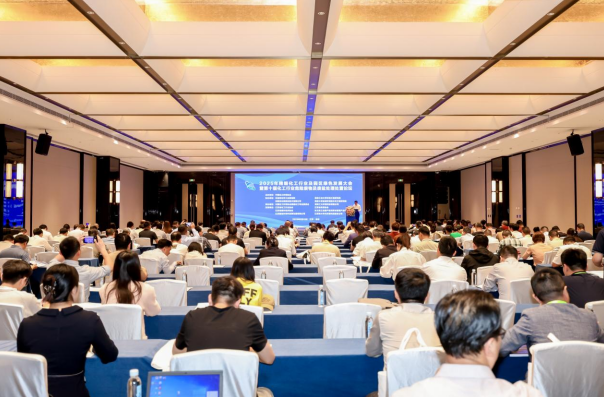The refined industrial sector is committed to high-quality and efficient development to jointly promote green transformation
As the "15th Five-Year Plan" period approaches, the fine chemical industry must not only continue to promote structural adjustment, transformation and quality improvement, but also be well-prepared for new requirements such as dual control of carbon emissions and the treatment of new pollutants. At the 2025 Fine Chemical Industry and Park Green Development Conference and the 10th Chemical Industry Hazardous Waste and Waste Salt Treatment and Disposal Forum, hosted by the China Chemical Environmental Protection Association from May 14th to 16th, experts attending the conference unanimously agreed that the green development of the fine chemical industry is shifting from "passive response" to "active change". The transformation of the development paradigm will promote the resolution of typical environmental governance challenges represented by waste salt, adding new impetus to achieving green and high-quality development.

Zhou Xianhui, the president of the China Chemical Environmental Protection Association, pointed out that the green transformation of the fine chemical industry is confronted with challenges such as significant pressure in safety and environmental protection management, insufficient supply of high-end products, and unbalanced regional development. Looking ahead to the 15th Five-Year Plan period, the industry should take achieving stable growth as a breakthrough point, take the initiative to seek changes, and focus on doing well in four aspects of work: building an environmental governance system, a technological innovation system, a green development system, and optimizing the industrial layout.
Yu Hongxia, the president of the Jiangsu Environmental Science Society, further pointed out that currently, the problems of new and traditional pollutants are intertwined. The industry urgently needs to build a comprehensive basic database and platform, and tackle a number of key core technologies to establish a collaborative control mechanism for environmental risks throughout the entire life cycle.
Wang Yu, vice president of the Petroleum and Chemical Industry Planning Institute, said that during the "15th Five-Year Plan" period, green transformation will remain one of the "main themes" of the fine chemical industry. The industry can leverage the power of large-scale equipment renewal and green and low-carbon technological transformation to drive low-carbon transformation. Promote green development by leveraging the power of clean production transformation and upgrading of environmental protection facilities. Leverage the power of clean energy and raw material substitution to promote coupled circular development and seek new paths for enhancing supply capacity and advancing product upgrading.
Waste salt management is the top priority in environmental governance in the fine chemical industry, and the resource utilization of waste salt also brings new opportunities for the development of the industry. According to Zhao Weijian, the chairman of the Supervisory Board of Jiangsu Chemical Industry Association and the executive vice chairman of Jiangsu Chemical and Chemical Engineering Society, Jiangsu is promoting the coupled development of waste salt resource utilization and existing ion-exchange membrane caustic soda projects, breaking the previous operation mode, and simultaneously solving the raw material problems for waste salt disposal and new caustic soda production capacity, thereby achieving the synergy of pollution reduction and carbon emission reduction.
The key to achieving this goal lies in the efficient removal of organic pollutants from waste salt. Xu Yanhua, the director of the Institute of Environmental Engineering at Nanjing Tech University, said that the thermochemical treatment technology for waste salt independently developed by the university can help achieve a "win-win" situation. At present, this technology has moved from the laboratory to industrialization and has been put into practical application in many places in China. The regenerated brine has fully met the indicators for entering the ion-exchange membrane caustic soda tank.
Tang Zhengdong, the president of Jiangsu Circular Economy Association and the executive president of the Yangtze River Delta Industrial By-product Salt Utilization and Management Industry Alliance, also pointed out that for promoting the treatment and resource utilization of waste salt, co-construction and sharing are of great significance. First, all relevant parties should jointly tackle the key technical challenges in the resource utilization of waste salt. Second, promote the joint construction and sharing of hazardous waste disposal facilities across regions to enhance the capacity for collaborative disposal. Third, jointly build a green standard system to guide the standardized development of the industry.
Establishing a waste salt evaluation technology system that includes "identification of characteristic pollutants - risk assessment - setting of control indicators - design/optimization of harmless treatment processes - identification of resource utilization products", and ultimately forming an integrated solution for identification, removal and utilization, will provide support for finding new outlets for waste salt. Dr. Hou Songmei from Shenyang Research Institute of Chemical Industry Co., Ltd. also mentioned the significance of standard guidance in promoting the resource utilization of waste salt.
During the conference, four sub-forums were held, covering the standardized construction and development of the park, the green development of fine chemicals, the treatment and disposal of hazardous waste and waste salt, and the control of VOCs and carbon reduction and pollution control. These forums gathered industry forces to promote the high-end, green and digital transformation of the fine chemicals industry.
